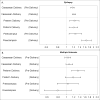Assessment of recording bias in pregnancy studies using health care databases: An application to neurologic conditions
- PMID: 29569366
- PMCID: PMC5980700
- DOI: 10.1111/ppe.12459
Assessment of recording bias in pregnancy studies using health care databases: An application to neurologic conditions
Abstract
Background: Pre-existing conditions are imperfectly recorded in health care databases. We assessed whether pre-existing neurologic conditions (epilepsy, multiple sclerosis [MS]) were differentially recorded in the presence of major obstetric outcomes (Caesarean delivery, preterm delivery, preeclampsia) in delivery records. We also evaluated the impact of differential recording on measures of frequency and association between the conditions and outcomes.
Methods: The 2011-2014 Truven Health MarketScan® Commercial Claims Dataset was used to identify pregnancies. We calculated the relative recording of epilepsy and MS at delivery hospitalization compared with a 270-day pre-delivery window both overall and by the presence of major obstetric outcomes. We estimated risk ratios for the association between epilepsy and MS with the outcomes for each ascertainment window.
Results: We identified 909 065 pregnancies in women continuously enrolled from 270-days before the delivery date. Of women with epilepsy identified in the pre-delivery window, 73% had the condition coded at delivery. For MS, the proportion was 60%. MS recording at delivery did not vary by obstetric outcomes, however, delivery-coded epilepsy was less likely confirmed in the pre-delivery window in the presence of preeclampsia. Generally, the period of ascertainment did not meaningfully impact risk ratios, however, the risk ratio for preeclampsia associated with epilepsy was 1.67 (95% CI 1.47, 1.90) when epilepsy was ascertained at delivery and 1.26 (95% CI 1.07, 1.48) when epilepsy was ascertained in the pre-delivery window (heterogeneity, P = .007).
Conclusions: Ascertainment of epilepsy and MS in delivery hospitalization records underestimated prevalence. However, the window of recording generally did not impact risk ratio estimates of associations with obstetric outcomes.
Keywords: administrative claims; bias (epidemiology); epilepsy; health care; multiple sclerosis; pregnancy.
© 2018 John Wiley & Sons Ltd.
Figures



Comment in
-
Making the best use of data not created for research.Paediatr Perinat Epidemiol. 2018 May;32(3):287-289. doi: 10.1111/ppe.12466. Epub 2018 Mar 25. Paediatr Perinat Epidemiol. 2018. PMID: 29575116 Free PMC article. No abstract available.
Similar articles
-
Pregnancy Outcomes in Women With Multiple Sclerosis.Am J Epidemiol. 2019 Jan 1;188(1):57-66. doi: 10.1093/aje/kwy197. Am J Epidemiol. 2019. PMID: 30165561 Free PMC article.
-
Obstetric outcomes in women with multiple sclerosis and epilepsy.Neurology. 2009 Dec 1;73(22):1831-6. doi: 10.1212/WNL.0b013e3181c3f27d. Epub 2009 Nov 18. Neurology. 2009. PMID: 19923552
-
Mortality and Morbidity During Delivery Hospitalization Among Pregnant Women With Epilepsy in the United States.JAMA Neurol. 2015 Sep;72(9):981-8. doi: 10.1001/jamaneurol.2015.1017. JAMA Neurol. 2015. PMID: 26147878 Free PMC article.
-
Global variation in pregnancy complications in women with epilepsy: A meta-analysis.Eur J Obstet Gynecol Reprod Biol. 2017 Aug;215:12-19. doi: 10.1016/j.ejogrb.2017.05.016. Epub 2017 May 30. Eur J Obstet Gynecol Reprod Biol. 2017. PMID: 28591672
-
Maternal and neonatal outcomes after bariatric surgery; a systematic review and meta-analysis: do the benefits outweigh the risks?Am J Obstet Gynecol. 2018 Jun;218(6):573-580. doi: 10.1016/j.ajog.2018.02.003. Epub 2018 Feb 15. Am J Obstet Gynecol. 2018. PMID: 29454871
Cited by
-
Use of real-world evidence from healthcare utilization data to evaluate drug safety during pregnancy.Pharmacoepidemiol Drug Saf. 2019 Jul;28(7):906-922. doi: 10.1002/pds.4789. Epub 2019 May 10. Pharmacoepidemiol Drug Saf. 2019. PMID: 31074570 Free PMC article. Review.
-
Pregnancy Outcomes in Women With Multiple Sclerosis.Am J Epidemiol. 2019 Jan 1;188(1):57-66. doi: 10.1093/aje/kwy197. Am J Epidemiol. 2019. PMID: 30165561 Free PMC article.
-
Maternal Hypertensive Disorders in Pregnant Women With Systemic Lupus Erythematosus and Future Cardiovascular Outcomes.Arthritis Care Res (Hoboken). 2021 Apr;73(4):574-579. doi: 10.1002/acr.24160. Arthritis Care Res (Hoboken). 2021. PMID: 32004410 Free PMC article.
-
Emulating a target trial of the comparative effectiveness of clomiphene citrate and letrozole for ovulation induction.Hum Reprod. 2022 Apr 1;37(4):793-805. doi: 10.1093/humrep/deac005. Hum Reprod. 2022. PMID: 35048945 Free PMC article.
-
Preterm birth phenotypes in women with autoimmune rheumatic diseases: a population-based cohort study.BJOG. 2020 Jan;127(1):70-78. doi: 10.1111/1471-0528.15970. Epub 2019 Oct 31. BJOG. 2020. PMID: 31571337 Free PMC article.
References
-
- Drews CD, Kraus JF, Greenland S. Recall bias in a case-control study of sudden infant death syndrome. Int J Epidemiol. 1990;19(2):405–411. - PubMed
-
- Yasmeen S, Romano PS, Schembri ME, et al. Accuracy of obstetric diagnoses and procedures in hospital discharge data. Am J Obstet Gynecol. 2006;194(4):992–1001. - PubMed
Publication types
MeSH terms
Grants and funding
LinkOut - more resources
Full Text Sources
Other Literature Sources
Medical

